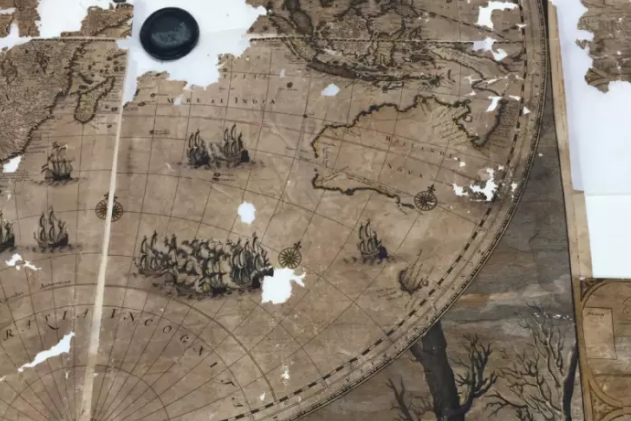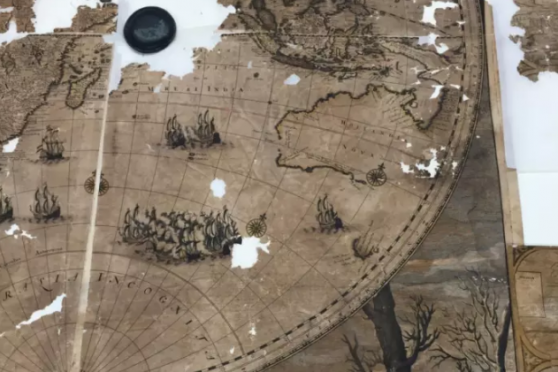A rare antique map that was found stuffed up a chimney in Aberdeen to stop draughts has been saved following intricate conservation work at the National Library of Scotland.
The document – which grateful experts said could easily have ended up at the bottom of a builder’s skip – has been revealed to be a late 17th century wall map of the world produced by the Dutch engraver Gerald Valck and there are only two other known copies in existence.
The map was recovered during renovation on a house and was destined for the skip before someone had second thoughts and it was gifted to the National Library. It was in a very poor condition, encrusted with dirt, and severely damaged in places after being attacked by vermin and insects.

It arrived at the Library rolled up in a plastic bag. Conservationists at the Library say that once removed, it “looked like a bundle of rags and had to be handled extremely carefully as fragments of the map fell off like confetti every time it was moved”.
On closer examination, it became clear that the canvas backing on the map had survived better than much of the paper itself which had disintegrated in a number of places.
The map is large, measuring seven feet by five feet (2.2 metres by 1.6 metres) and, in its time would have been hung on a wall to be admired by visitors. A similar map from the same period is shown in the famous painting by the Dutch master Vermeer called “Painter in his Studio”.
The work to clean and restore the map proved to be one of the most complex yet undertaken by the National Library of Scotland’s conservation department.
It involved a variety of specialist treatments which covered five key stages – opening and flattening the map; separating it into its original eight sections; removing the linen backing; dry cleaning and washing the paper; re-assembling the cleaned sections onto a new paper lining.

Claire Thomson, book and paper conservator at the Library, who worked on the project, said today: “Once the map was unfurled I was able to assess its condition, which I must admit filled me with dread.
“Much of the paper had been lost, and the remainder was hard and brittle in places and soft and thin in others. We needed to stabilise it to prevent any further deterioration, make it robust and easier to handle to get to a point where it could be studied by researchers.”
The map was originally printed in eight separate sections and adhered to a linen backing. It was already splitting along the joins between the sections and the decision was taken to separate the sections to make the map easier to work with. These were each placed in a humidifying chamber as the gentle introduction of moisture made it easier to flatten out the map.

Removing the backing without further damaging the paper proved to be one of the most difficult tasks. This involved using a thick cellulose solution to fix light weight Japanese paper to the front of the map in two layers. This secured the paper map while the backing was peeled off using hand tools.
The final stage of cleaning involved suspending the map sections individually in water in a heated sink at 40C for 40 minutes with the water being gently agitated to clean dirt from the surface. On removal they were placed in blotters to remove any excess water. After unknown years of neglect and misuse, the detailed splendour of a map created in a 17th century Dutch printing house was revealed.

National Librarian Dr John Scally added: “This is one of the most challenging tasks our conservation team has faced and they have done a terrific job. Although significant sections of the map have been lost, the remainder has been cleaned and stabilised for future study and enjoyment.
“It would have been very easy for this map to end up at the bottom of a skip but thankfully it can now take its place among the magnificent maps held within our collection.”
Two short films have been made showcasing the conservation work and exploring the history of the map.
